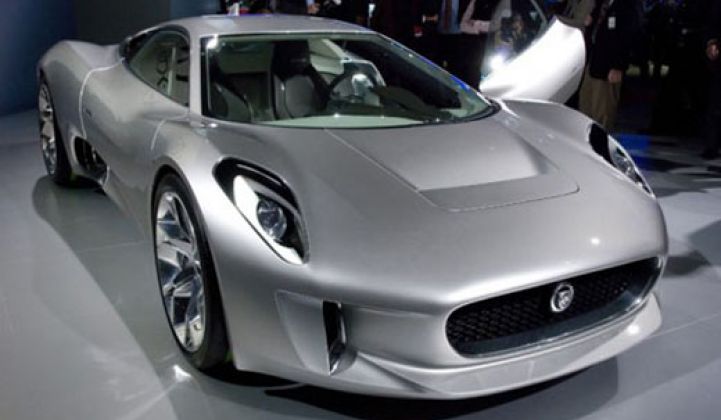Of all the exciting cars introduced at this year’s Paris Motor Show, many people would be hard-pressed to tell the difference between those that are propelled by electricity and those using a standard internal combustion engine without reading the spec sheets. No longer is a car cool simply because it’s electric; now, automakers realize that EVs should be cars that people would actually want to drive.
On the first day of the show, the heavy hitters instantly brought out the goods, starting with Jaguar. Having yet to offer a conventional gas-electric hybrid, the company rolled out its stunning gas-electric plug-in, the C-X75. Sporting a similar shape to the company’s ill-fated XJ220, the C-X75 is powered by four electric motors that produce a total of 780 hp. Fueling these four motors is a lithium-ion battery pack, and when the juice runs out after 68 miles (the vehicle’s range), a pair of gas-turbine (read: JET) engines spool up to 80,000 rpm to recharge the batteries and extend the range to over 500 miles. And I haven’t even mentioned the performance yet! The move from 0-60 mph takes just 3.4 seconds and the car supposedly tops out at 205 mph. Certainly makes the Tesla Roadster seem woefully inadequate with its 125 mph top speed and limited range.
Other sports EV introductions included the Renault DeZir, a lightweight 2-seater that makes use of Renault’s 150-hp ZE electric engine and borrows their Formula 1 car’s Kinetic Energy Recovery System (KERS), which stores energy from a regenerative braking system and then dispenses energy on demand, the SEAT IBe, with 102 hp and a 130-mile range, and the French-built Exagon Furtive-eGT, which supposedly will rocket to 60 mph in 3.5 seconds and have an electric-only range of up to 250 miles. Slated to be on the road by 2012, it’s doubtful that some of the company's Exagon claims will hold true.
While these cars are exciting, practically, they make very little sense. The practical, everyday EVs are a little harder to find -- and for good reason. At the Nissan booth, the company has its Townpod EV concept on display and seems to have achieved the impossible. No, not an unlimited range, but rather a more awkward-looking version of the soon-to-be-available Leaf. This marshmallow-esque vehicle with insect-eye headlights will supposedly slot into an entire range of electric vehicles that Nissan plans to introduce. Nissan provided no details about powertrain, output, charge time, or range, so we can only hope the laws of engineering force the designers to re-imagine the Townpod.
Kia puts its own spin on the EV with the Pop. From the vehicle’s spec sheet, it seems perfectly reasonable: a 67 hp electric motor, 18kW lithium polymer gel battery from LG, and a range of 100 miles -- perfect for city driving. Style-wise, it looks even stranger than the Nissan. Riddled with LEDs and chromed plastic, if this is the future of EVs, it’s truly a bright one -- and not necessarily in a good way.
Lotus, which wowed show-goers by introducing five new sports cars, also brought its own plug-in hybrid, the City Car Concept. Its intended purpose is most certainly to help Lotus meet the rising fleet fuel economy standards in Europe. Much more reasonably styled than the Nissan and the Kia, and with an electric-only range of 35 miles, adequate for most daily commutes, this sporty 3-seater would not look out of place on the road today, thought it isn’t, unfortunately.
What about the cars that are likely to be on the road soon? The long-awaited, plug-in Fisker Karma sport sedan is ready to hit the pavement with its two rear-wheel mounted electric motors tied to a lithium-ion battery. But when the driver actually wants to make use of the car’s claimed 400-hp, they must engage the GM-sourced turbocharged 4-cylinder engine. With a base price of $87,900, you will probably not see it on the road soon -- or ever.
So, the EVs and plug-ins displayed in Paris that most people would want to have will probably never see production and can’t transport more than a driver and passenger, the cars that are practical and could potentially get the green light make the Ford Pinto look like an Alfa Romeo, and the one car that is set to go on sale is destined to become a rich person’s plaything.
But, some rays of hope may shine out from the City of Light yet, and they come on two wheels.
Mini and Smart have introduced electric scooter concepts, both of which look cool and techie without being too futuristic for the average human to use. Both incorporate hub-mounted motors with lithium-ion battery packs under the seat and, with ranges in excess of 50 miles, seem to be the perfect city vehicle. The Smart even has solar cells incorporated into the windscreen to charge the battery. But most scooter owners do not have a garage with an outlet (if they did, they would probably have a car), and the sidewalks where they park generally do not have outlets, so these neat concepts are almost practical. Almost….
With more than a week left before the Paris Motor Show closes, we’ll look for more reasonable, and livable, offerings from companies such as Ford, GM, BMW, Mercedes and Saab.



